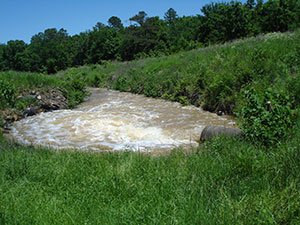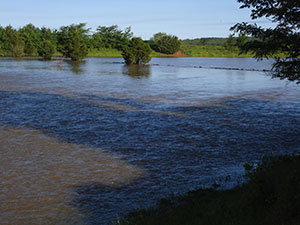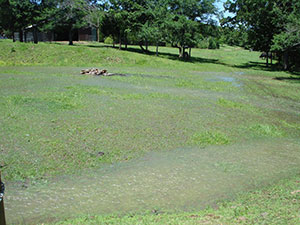Millions in damages prevented by dams, conservation practices during historic May rainfall
OKLAHOMA CITY (May 12, 2015)—Oklahoma’s network of 2,107 flood control dams and voluntary conservation practices prevented an estimated $22.57 million in flood damages from the May 1-9 storms according to the USDA Natural Resources Conservation Service (NRCS) Water Resource Office.

“The flood control network was designed to protect farmland, roads, bridges, homes and lives, and that’s exactly what we’ve seen over the last week of rainfall,” said Trey Lam, Oklahoma Conservation Commission (OCC) executive director. “Like any form of infrastructure, operation and maintenance of these dams is critical if we hope to continue reaping the benefits they provide.”
According to Oklahoma Mesonet, May 2015 is so far the wettest since 1921. Some of the hardest working dam clusters over the last 10 days include:
- Fourche Maline Creek watershed, Latimer County, 14 dams, 9.97 inches of rain, $819,272 in damage prevented
- Upper Clear Boggy Creek watershed, Coal, Johnston, and Pontotoc Counties, 49 dams, 10.1 inches of rain, $1,029,641 in damage prevented
- Sandy Creek watershed, Garvin and Pontotoc Counties, 29 dams, 8.11 inches of rain, $764,362 in damage prevented
- Okfuskee Tributaries, Okfuskee and Okmulgee Counties, 29 dams, 7.89 inches of rain, $693,985 in damage prevented

Rainfall averages from National Oceanic and Atmospheric Administration (NOAA).
“Local conservation districts and the private landowners they work with also deserve credit for this success,” said Gary O’Neill, NRCS state conservationist. “It’s important we not lose sight of the other side of the coin—soil health. Healthy soils achieved through voluntary conservation practices are crucial to halting the extensive flood and wind related erosion witnessed in this state during the 1930s and ‘50s.”
Practices such as no-till farming and stream bank fencing mean stabilizing ground cover is in place when floodwaters rise. Due to higher levels of organic matter above and within the soil, healthy soil withstands flooding, erosion and drought better than bare or plowed soil.

“High residue, no-till and cover crops build soil that is more resilient to climate extremes—both flood and drought.” said Greg Scott, OCC soil scientist. “Organic matter, earthworms and roots hold soil in place and provide pathways through the soil for water to infiltrate. Bare soil seals off, crusts over and can be almost as ineffective as concrete at absorbing water, especially in flood events.”
